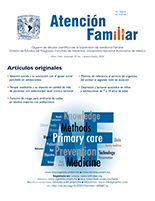Elderly Falling over Syndrome Risk Factors and Polypharmacy
Main Article Content
Abstract
Objective: To determine the risk factors associated with the elderly falling over syndrome with polypharmacy. Methods: cross-sectional study conducted from March to April 2019. Adults over the age of 60 were included who attended an external consultation in the Family Medicine Unit No. 28, with prescription and minimum consumption of four drugs simultaneously (polypharmacy). The World Health Organization (who) study questionnaire was used to assess falls. The assessed variables as risk factors for falls were: age, gender, marital status, education, weight, size, body mass index, medications, comorbidities and the use of external supports when moving. To understand the differences according to the presence of falls, the χ2 test in the qualitative variables was used; to determine the risk factors for falls, or were calculated and an adjusted logistic regression model was made for the use of antidepressants, diuretics and benzodiazepines. Results: A total of 264 patients were included, the average medicines consumed were six (ric 4-7), the most frequently prescribed drugs were antihypertensive, nonsteroidal anti-inflammatory drugs and diuretics. Of the total participants, 79 had falls in the last six months (29.9%). When analyzing risk factors associated with falls in the multivariate model, the use of antidepressants showed an or 3.14 (ic95% 1.46-6-71) and diuretics an or 1.84 (IC95% 1.1-3.37). Conclusion: the risk factors associated with falls in patients with polypharmacy were the use of antidepressants and diuretics.
